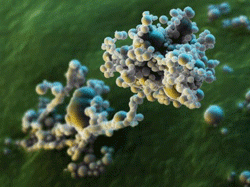Steady voltage for processors: Carbonyl iron powder from BASF improves electrical components for smartphones and tablet PCs

Portable tablet PCs are increasingly
indispensable companions for many
people. But the more advanced
these devices become, the greater
the demands placed on their components.
Photo: BASF
Smartphone, tablet PC, notebook – many people would now find it hard to imagine a life without these small, sophisticated devices.
Manufacturing these complex electronic products in a portable format is only possible using very high performance components. It also means that some components like the CPU or hard disk need current with a different voltage than supplied by the battery. Voltage deviating from the required value damages these components.
High-purity carbonyl iron powder (CIP) from BASF contributes decisively to solving this problem: incorporated in the cores of high frequency coils it makes sure that the current flowing into the sensitive electronics always has exactly the required voltage.
“With our decades of experience in synthesizing CIP, we can precisely control the structure of the iron particles and thus their electromagnetic properties to create an optimal material, thereby making even very small high-frequency coils extremely efficient,” stated Dr. Frank Prechtl, Business Manager at BASF. “Every tablet PC contains three or four of these high-frequency coils with CIP core, and a notebook has as many as ten.”

Their perfect spherical shape makes
the particles of carbonyl iron powder
from BASF particularly suitable for use
in electronic components such as
high-frequency coils. Photo: BASF
CIP Production
CIP is produced from normal scrap iron, which is finely ground and reacted with carbon monoxide at increased temperatures under high pressure. This process yields iron pentacarbonyl, an oily yellow fluid. At this stage, the impurities present in the scrap iron can be easily removed: as a liquid, iron pentacarbonyl can be distilled and obtained in very high purity.
The compound is then heated until it decomposes again into its constituents. The carbon monoxide released during this treatment can be recycled for the synthesis of iron pentacarbonyl.
The iron, however, is deposited in the form of high purity, microscopically small spherical particles of exactly defined structure and size – carbonyl iron powder. In this respect, CIP differs markedly from iron powders manufactured using other techniques, such as electrolytic processes or atomized methods.
This is the decisive factor for many applications – for example, the perfect spherical shape of the CIP particles in the coil cores allows them to be packed together particularly tightly and the wires of the coil are not scratched by a rough surface.
Innovative applications
A coil is an electrical component consisting of a multiply wound copper wire. The current flowing through the copper wire creates a magnetic field in and around the coil. If the voltage of the current changes, the magnetic field counteracts this change: the phenomenon of induction ensures that the current leaving the coil maintains a constant voltage. This effect comes into play when, for example, the coil is positioned behind a direct-current converter which changes the voltage of direct current. To do this, it converts it to alternating current in an intermediate step and later back again. The high frequency coil then filters out the remaining alternating current components and “smoothes” the direct current so the voltage no longer fluctuates.
The stronger the coil’s magnetic field, the better the induction works. This is why the high frequency coils in smartphones and other devices have a core made from a magnetic material like iron which greatly intensifies the magnetic field of the current coil. To prevent energy losses of the kind occurring with an electrically conductive iron core, for example, each of the tiny iron particles in CIP cores is surrounded by an electrically insulating layer. This suppresses additional current flows which would otherwise be created by the induction in the core.
“The shape of the CIP particles contributes greatly to reducing the energy losses in the coil cores: the rounder the particles, the more easily they can be coated and the more effectively they are insulated against electrical current,” explains BASF Product Manager Dr. Oliver Koch. “In the high-frequency coils we generally use iron phosphate for this purpose but we can also adapt the coating material to meet the individual requirements of innovative technologies. This allows us to search specifically for new applications even for an established product like CIP and manufacture a high performance product suited to the application.”
Another example of such innovative applications can be found in magnetorheologic fluids (MRF), suspensions of CIP in an oil: when introduced into a magnetic field, they change their flow properties in milliseconds and become very viscous or even solid. This effect occurs because when the iron particles are in the magnetic field, they are no longer evenly distributed in the oil but arrange themselves into chains, which increases the viscosity of the liquid. This makes MRF ideal for use in dampers – the viscosity and thus the damping can be flexibly adapted to the load via sensors and electromagnets.
This BASF technology is now already being used in, for example, the dampers of the Alamillo bridge in Seville, Spain and the Sutong bridge near Nantong in China.





